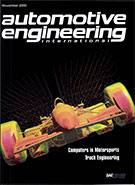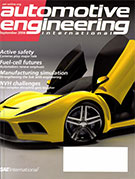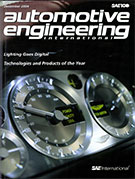Magazine

Autonomous Vehicle Engineering: March 2019
2019-03-07
Editorial It's more than just a magazine The Navigator Needed: a step beyond STEM SAE AV Activities A listing of SAE International's autonomous vehicle-related offerings across the organization. Autonomy for the Masses Ford Autonomous Vehicles LLC aims to do for AVs what the Model T did for just about everyone. CEO Sherif Marakby explains. Speeding Thermal Analysis for Autonomous EVs Solving thermal challenges is vital to AEV development. Siemens PLM's new Simcenter integrated simulation package offers a high-fidelity, easy-to-use solution. New Mobility's Mega-Mappers Most believe ultrahigh-definition mapping is crucial to make high-level automated driving possible. Developing these maps is a huge undertaking-one that's enjoying a massive investment of money and talent. From a Blip to a Boom Automotive radar rides the 77-GHz technology wave toward greater capability and vehicle safety.



















